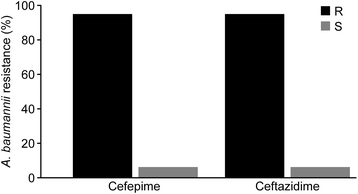Molecular characterization of extended-spectrum beta-lactamases (ESBLs) produced by clinical isolates of Acinetobacter baumannii in Saudi Arabia
- PMID: 26290183
- PMCID: PMC4545919
- DOI: 10.1186/s12941-015-0098-9
Molecular characterization of extended-spectrum beta-lactamases (ESBLs) produced by clinical isolates of Acinetobacter baumannii in Saudi Arabia
Abstract
Background: Acinetobacter baumannii is a common opportunistic pathogen that causes major nosocomial infections in hospitals. In this study, we hypothesized a high prevalence of A. baumanni ESBL (extended-spectrum beta-lactamase) among all collected isolates.
Methods: A. baumannii isolates (n = 107) from ICU (Intensive care unit) of local hospitals in Makkah were phenotypically and genotypically characterized. The identity and antibiotic susceptibility of A. baumannii strains were determined using the Vitek-2 system. The identified ESBL producers were further analyzed by PCR and sequencing followed by MLST typing. bla TEM , bla SHV , and the bla CTX-M-group genes 1, 2, 8, 9, and 25 were investigated. Furthermore, bla OXA51-like and bla OXA23-like genes were also examined in the carbapenem-resistant A. baumannii isolates.
Results: Our data indicated a high prevalence of A. baumannii ESBL producers among the collected strains. Of the 107 A. baumannii isolates, 94 % were found to be resistant to cefepime and ceftazidime, and aztreonam using the Vitek 2 system. The genes detected encoded TEM, OXA-51-like and OXA-23-like enzymes, and CTX-M-group proteins 1, 2, 8, 9, and 25. MLST typing identified eight sequence type (ST) groups. The most dominant STs were ST195 and ST557 and all of them belong to worldwide clonal complex (CC) 2.
Conclusions: This study has shown that there is a high prevalence of antimicrobial resistance in A. baumannii. The diversity of STs may suggest that new ESBL strains are constantly emerging. The molecular diversity of the ESBL genes in A. baumannii may have contributed to the increased antimicrobial resistance among all isolates.
Figures




References
-
- Srinivasan VB, Rajamohan G, Pancholi P, Stevenson K, Tadesse D, Patchanee P, Marcon M, Gebreyes WA. Genetic relatedness and molecular characterization of multidrug resistant Acinetobacter baumannii isolated in central Ohio, USA. Ann Clin Microbiol Antimicrob. 2009;8(1):21. doi: 10.1186/1476-0711-8-21. - DOI - PMC - PubMed
Publication types
MeSH terms
Substances
LinkOut - more resources
Full Text Sources
Other Literature Sources

